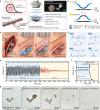An on-demand bioresorbable neurostimulator
- PMID: 37951985
- PMCID: PMC10640647
- DOI: 10.1038/s41467-023-42791-5
An on-demand bioresorbable neurostimulator
Abstract
Bioresorbable bioelectronics, with their natural degradation properties, hold significant potential to eliminate the need for surgical removal. Despite notable achievements, two major challenges hinder their practical application in medical settings. First, they necessitate sustainable energy solutions with biodegradable components via biosafe powering mechanisms. More importantly, reliability in their function is undermined by unpredictable device lifetimes due to the complex polymer degradation kinetics. Here, we propose an on-demand bioresorbable neurostimulator to address these issues, thus allowing for clinical operations to be manipulated using biosafe ultrasound sources. Our ultrasound-mediated transient mechanism enables (1) electrical stimulation through transcutaneous ultrasound-driven triboelectricity and (2) rapid device elimination using high-intensity ultrasound without adverse health effects. Furthermore, we perform neurophysiological analyses to show that our neurostimulator provides therapeutic benefits for both compression peripheral nerve injury and hereditary peripheral neuropathy. We anticipate that the on-demand bioresorbable neurostimulator will prove useful in the development of medical implants to treat peripheral neuropathy.
© 2023. The Author(s).
Conflict of interest statement
D.-M.L., M.K., and S.-W.K. are inventors on the patent (KR/ 10-2348997) and patent application (US/ 17/515,675) filed through the Sungkyunkwan University Research and Business Foundation which cover the on-demand bioresorbable neurostimulator for peripheral nerve electrotherapy used in this work. Energymining Co., Ltd. acquired the patent and patent application through technology transfer. The remaining authors declare no competing interests.
Figures




References
-
- Robinson, A. J. & Snyder-Mackler, L. Clinical Electrophysiology: Electrotherapy and Electrophysiologic Testing (Lippincott Williams & Wilkins, 2008).
Publication types
MeSH terms
LinkOut - more resources
Full Text Sources
Medical

